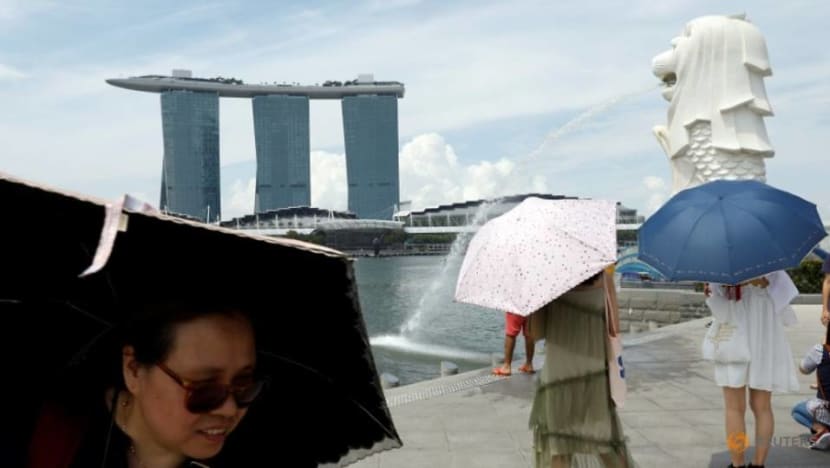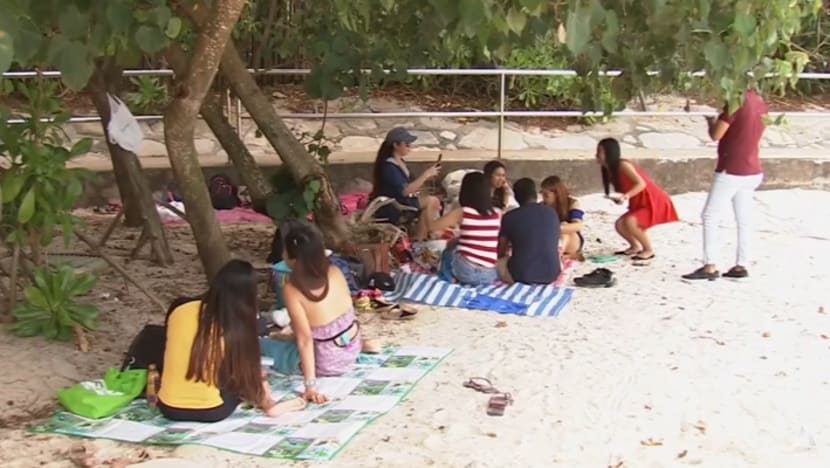- Joined
- Apr 14, 2011
- Messages
- 20,071
- Points
- 113
A warmer Singapore could spell trouble for its tourism industry, say experts
To mitigate the effects of the heat, various tourist attractions have put in place initiatives to keep people and places cool.
Listen to this article
6 min
This audio is generated by an AI tool.
Nadirah Zaidi

Darrelle Ng
16 Jan 2024 02:59PMBookmark
WhatsAppTelegramFacebookTwitterEmailLinkedIn
SINGAPORE: A warmer and wetter Singapore could dampen the appeal of the nation as a tourist destination, experts warned.
Projections from the latest National Climate Change Study showed that the country will experience progressively hotter days, more frequent and longer dry spells, and more extreme rainfall.
All these could impact the types of activities and attractions on offer, and discourage some tourists from visiting the sunny island, said analysts.
“If the temperature increases, but at the same time it is more humid … (at some point) it becomes quite impossible for people to stay outside in the sun and this makes movement more restricted,” said Professor Abhishek Bhati, campus dean of James Cook University Singapore.
“If our rainfall increases, then tourists are not getting the benefit of coming to a clear and sunny tourist destination,” he added. “So if Singapore is not able to offer the benefits which tourists are looking for, then they may start to look elsewhere.”
WARMER DAYS AHEAD
The study, released earlier this month by the Center of Climate Research Singapore, said that the nation’s mean temperature could rise by between 0.6 and 5 degrees Celsius by the end of the century, depending on the world’s carbon emissions rate.Very hot days, during which the maximum temperature exceeds 35 degrees Celsius, will also become more frequent.
For tourists favouring the outdoors, the warmer weather could affect their experience in the nation's many open spaces, including the Mandai Wildlife Reserve.
“Imagine you're going to see sea lions or tigers, but these animals are never outside, they're always (hiding in the shade) because it is too hot. So as a tourist, you're not getting the value that you expect of seeing an open zoo,” said Prof Bhati, who is also the regional vice president of the International Tourism Studies Association.
Mean daily and maximum daily temperature across three scenarios (°C)
Singapore’s hawker culture could be also diminished if the temperature becomes unbearable for dining outdoors.
“Alfresco eating places will have to have mitigating measures that could change their attractiveness. There will be fewer open air dining spaces. Everything will be enclosed in air-conditioned spaces,” said Prof Bhati.
With the soaring heat, visitors along shopping belts such as Orchard Road could also want to venture in sheltered areas more, which could change how shopping centres have to deal with cooling systems.
“With more people indoors, the air conditioning has to work harder. More cooling measures will have to be installed in shopping malls,” said Prof Bhati.
RISING SEA LEVELS
The climate change study also warned that rising tides are inevitable, with a projection of between 0.23m to 1.15m increase in mean sea level by the year 2100.Experts said the sea could encroach into low-lying and coastal areas such as East Coast Park, Marina Bay and Sentosa.
Beaches would become smaller, while flora and fauna in low-lying areas could be lost. All these could make Singapore less attractive for tourists looking for a beach holiday or a slice of nature.
“Rising sea levels will reduce the shelf and the beach space which is available for people. If our beaches are no longer attractive, then they become a limited benefit for tourists,” said Prof Bhati.
“(We could also be looking at) more crowded spaces covered with concrete, with fixed reinforced structures, rather than trees or canopy.”

WETTER, WINDIER DAYS AHEAD
With rains set to become heavier and wind speeds expected to strengthen, experts said more resilient infrastructures that can withstand the impact of climate change will be needed.“Whatever happens to the climate, it's not in isolation, they all are going to impact our daily lives as well as the tourists who come here,” said Prof Bhati.
“Areas with a high concentration of outdoor attractions will need to mitigate the impacts of changes in temperature, rainfall and wind.”
The study said the rainy months of December to January could get wetter by up to 58 per cent by the end of the century, with more extreme daily rainfall across all seasons.
Daily maximum wind gusts are expected to increase by up to 10 per cent, which can potentially cause damage to infrastructure and uproot trees.
“As flooding is very closely associated with climatic changes, (floods) is one thing that we might see,” said Mr Kevin Phun, founder of the Centre for Responsible Tourism Singapore.
He pointed out that the government has actively invested in upgrading and improving the capacity of infrastructure to contain and drain rainwater.
ECO-TOURISM COULD BE KEY
To mitigate the effects of the heat, various tourist attractions have put in place initiatives to keep people and places cool.“(Our) animal care team deploys creative solutions to keep the animals cool in this tropical climate where temperatures have been progressively rising. These include installing sprinkler systems throughout the habitats that provide the animals a refreshing respite,” said the Mandai Wildlife Group, which runs the Singapore Zoo, Bird Paradise, River Wonders and Night Safari.
Aside from a constant supply of fresh water, animals also get specially crafted ice treats which serve as both a cooling agent and a source of enrichment on some hot days.

Across its attractions, the group maintains a high level of tree canopy cover to help lower the ambient temperature and offer shade to both animals and humans alike.
Green efforts such as these will be key in attracting more visitors to Singapore, analysts said.
Various hotels and other tourism businesses have also stepped up their sustainability playbook, such as getting rid of single-use items and installing energy-saving technologies.
Mr Phun said that the younger generation, particularly Gen Z, is increasingly invested in sustainable travel. Having environmental impacts in mind when implementing tourism initiatives could appeal to more such visitors, he added.
“Going forward, we will have a younger (demographic) of tourists who – studies in the last few years have shown – are very interested in green practices. They travel with a very different perspective from their parents,” he said.
Prof Bhati added: “Those who are able to manage global warming or these climate changes more effectively are going to be the tourist attractions that will be more resilient in the future.”


 anywhere they liked.
anywhere they liked.
